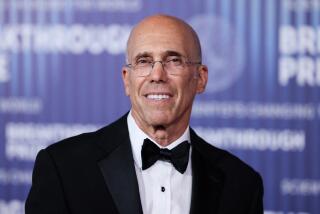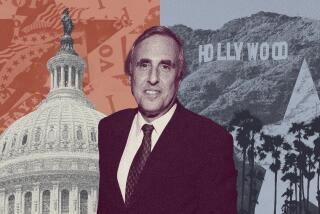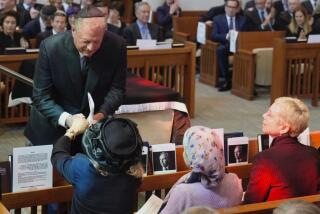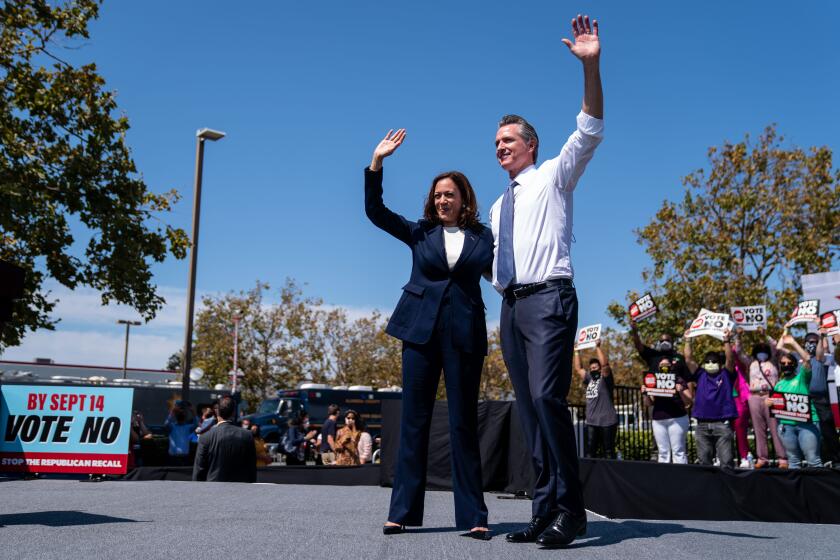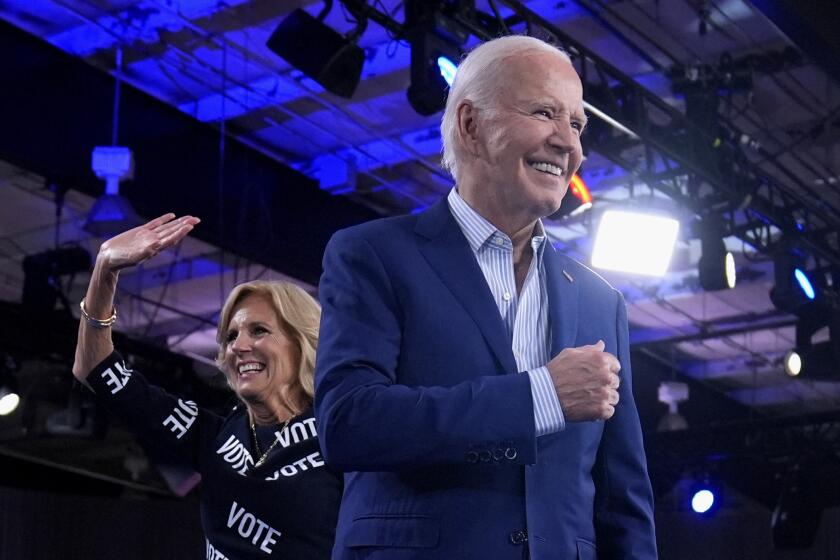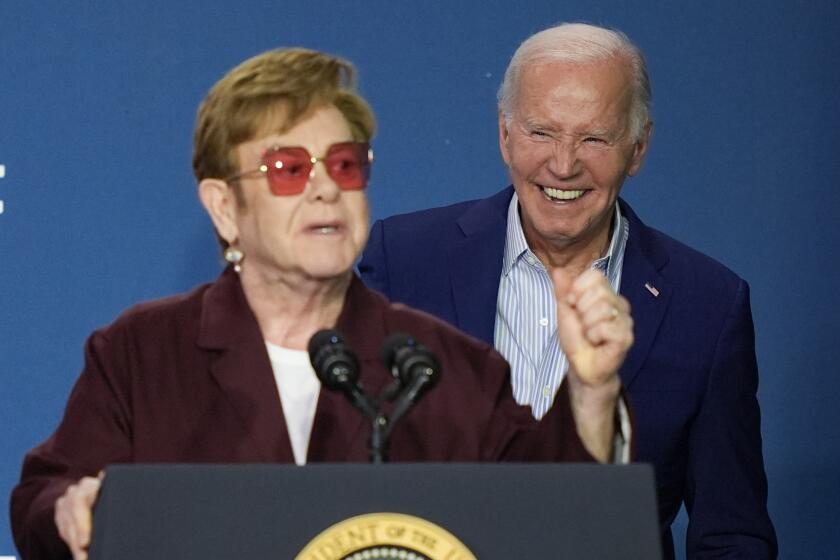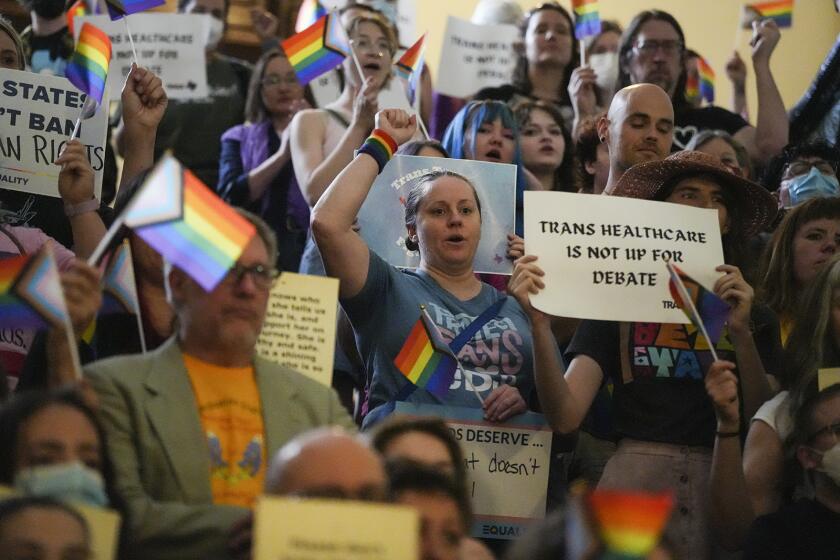5 Lobbyists, as Friends, Help Gore’s Rise
One of Al Gore’s first hires after he was elected to Congress in 1976 was Peter Knight, a hard-charging 25-year-old aide earning $20,700 a year. Roy Neel, a former Tennessee sportswriter, soon followed.
Gregory Simon, a rock ‘n’ roll drummer until age 30, joined Gore’s Senate staff in 1991. Jack Quinn, a lawyer, signed on to Gore’s ill-fated 1988 bid for the presidency before becoming his vice presidential chief of staff. Tom Downey, a congressional colleague, bonded with Gore during competitive, late-afternoon basketball games in the House gym.
As Gore’s political career took off, each man remained intensely loyal--raising money for his campaigns, dispensing advice or simply being a friend.
Knight, for instance, helped Gore land the contract for his bestselling book, “Earth in the Balance.” Neel helped arranged a memorial service in Nashville for Gore’s father. Downey introduced Gore’s eldest daughter to her future husband.
They are key figures in his kitchen cabinet, five men whose pasts--and, to some extent, futures--are inextricably linked to one of the most influential vice presidents in modern times. They have helped Gore rise to the brink of the presidency and, in turn, benefited handsomely.
Today, all five are off the public payroll, having turned their government ties and tenure into lucrative Washington lobbying work. Not coincidentally, the interests of their clients--from technology to telecommunications, from the environment to the Olympics--often have dovetailed with Gore’s public policy portfolio.
Case in point: While Gore was overseeing a commission to foster joint ventures between the United States and Russia, two American companies, Lockheed Martin and DuPont, paid Knight and Downey to lobby the White House on behalf of their corporate interests in Russia.
Group Is Not Typical of Kitchen Cabinets
The evolving relationships between Gore and the lobbyists are a window into how Washington works and how much that insular world has influenced the vice president.
To a striking degree, Gore has surrounded himself with a revolving door of political insiders whose careers he helped propel. These Gore advisors are unlike the business titans, self-made millionaires and home-state political leaders who typically have made up other White House kitchen cabinets.
“These individuals are classic representatives of the Washington insider-political-establishment way of doing business,” said Fred Wertheimer, president of Democracy 21, a public policy organization devoted to political reform. “And that is obviously not the message that the vice president wants to take to the country.”
For all of Gore’s efforts to distance himself from Washington--he moved his presidential campaign to Nashville in October, saying he was more a man of Tennessee than a creature of the Beltway--the vice president has received more campaign donations, $592,325, from lobbyists than any other presidential candidate, according to the Center for Responsive Politics, a nonpartisan Washington-based research group.
While Gore’s office maintains that the vice president has taken no improper action on behalf of his friends or their clients, the very nature of his inner circle raises questions about whether some White House decisions driven by the public good may also have hidden private interests.
“Every decision the president and the vice president has ever made has been based on . . . what is in the best interest of the country,” said Gore spokesman Chris Lehane.
Moreover, Lehane said, Gore has taken positions opposed to the interests of his friends’ clients on immigration, prescription drug and legal reform issues.
Added Simon: “As far as I’m concerned, the people around the vice president bent over backward not to even have an appearance of a conflict.”
All five lobbyists have seen their incomes soar during Gore’s vice presidency. Since 1997, clients have paid more than $17 million for their services.
Moreover, Gore’s ties to Quinn, Knight and Neel have led to prestigious or potentially lucrative presidential appointments.
If Gore is elected president, the stock of the five loyalists is certain to rise further, perhaps with positions in his administration or enhanced standing as Washington power brokers. Some Democratic insiders speculate that Gore’s chief of staff and attorney general could come from this group.
The lobbyists maintain that they have earned their newfound wealth primarily through expertise and experience, not simply because they are close to the vice president.
“I never made money in my life until I left government,” said Simon, who in 1997 opened a lobbying practice focused on the same issues he handled for Gore as his chief domestic policy advisor. “I think people hired me because, if I could give the vice president and, occasionally, the president good policy advice, I could give them good policy advice too.”
Alliances between political leaders and lobbyists are as common as marble colonnades in Washington, where people often work in the public sector for years, then cash in with private clients willing to pay generously for access and insights into government decision-making.
“It happens in this town,” said Neel, a former Gore chief of staff who has become a highly paid telecommunications lobbyist. “There is nothing illegal or untoward about it.”
In 1993, the Clinton administration swept into office decrying the influence of lobbyists who struck it rich after cutting their political teeth in government.
One of Clinton’s first official acts was to set up strict ethics rules banning senior presidential and vice presidential appointees, such as Quinn and Neel, from lobbying the White House for five years, and others who earned less, such as Simon, for one year after leaving the administration. The Gore advisors insist that they have followed those regulations and there is no indication that their lobbying activities have violated the ban.
No Evidence That Efforts Violated Rules
While the former Gore aides deny seeking to influence the vice president directly, Knight, Simon and close associates of Quinn all have lobbied Gore’s staff.
Downey, the former congressman, has lobbied Gore and his aides. “He has occasionally raised issues with the vice president, but the vice president has not taken action as a result of their conversation that he would not otherwise have taken,” Lehane said. “There’s been no special treatment.”
And the Gore associates all have enjoyed considerable access to Gore and his staff.
The vice president’s office acknowledged that former Gore chiefs of staff Knight, Quinn and Neel met occasionally with the vice president or his top aides for lunch over a period of several months ending last spring. In addition, all of the men except Simon belonged to a coterie of informal advisors that periodically met with Gore’s chief of staff in the White House complex. It was at one time nicknamed “The K Street Group,” after the Washington corridor where many lobbyists have their offices. And Knight, Downey and Neel have traveled with Gore on Air Force Two since October 1998.
Gore’s office declined to release Secret Service records that would show how many times each of the lobbyists had visited the White House.
The lobbyists have something else in common: Their firms and some of their clients are donors to Gore’s presidential campaign, the Clinton-Gore reelection, a fund to renovate the vice president’s residence and a scholarship at the University of Tennessee to honor his late sister.
Four of the lobbyists have helped finance Gore’s 2000 campaign, including Knight, the chief architect of the fund-raising effort. Downey has solicited more than $75,000, and Neel and Simon $25,000 each, Gore aides said. Quinn has raised no money.
At the same time, the advisors have lobbied the administration on a variety of policy issues.
On an April day in 1996, Knight attended a Cabinet-level meeting on the Olympics in Atlanta chaired by Gore, who headed the administration’s task force on the Games.
Knight served as Gore’s chief of staff from 1977 to 1989 and ran Gore’s 1988 presidential bid. He then worked for a pharmaceutical firm before becoming a lobbyist in 1991.
But he remained Gore’s major fund-raiser, helping bring in nearly $50 million for Gore’s political committees and other causes since 1983. He was deputy director of personnel for the Clinton-Gore transition team in 1992 and took a six-month leave in 1996 to head the Clinton-Gore reelection effort.
But on that April day, Knight wasn’t wearing any of those hats. He was at the White House as a paid lobbyist for both the U.S. and international Olympic committees. The outcome of the meeting: an announcement of a federal commitment for 1,000 more police officers at the Atlanta Games.
While a former Atlanta Olympics official said Knight played no role in the decision, his recurring presence at the White House underscores the symbiotic relationship between Gore and his friends.
Knight’s lobbying practice took off after Gore became vice president. Billings for clients he represented exceeded $2.5 million from 1997 to mid-1999. This included four different clients associated with the Olympics alone.
Gore told ABC-TV’s “This Week” in October: “Peter Knight has never, ever lobbied me. Ever. Not for a single client.”
Lobbyist Investigated but Not Charged
In addition, with Gore’s support, Knight was appointed by Clinton to the board of the Comsat Corp. in 1994, a quasi-public satellite communications firm. The high-profile post earned him $21,500 annually for several years but now pays him in stock options whose worth has fluctuated widely. Knight currently holds 13,402 options.
Some of Knight’s business activities have attracted controversy. In 1997, congressional Republicans investigated his role in deals involving several clients who also were Democratic donors. He was not charged with any wrongdoing.
Knight left his lobbying practice at the end of last year, primarily to assist the Gore campaign.
Among those closest to Gore is Downey, who lives across the street from the vice president’s mansion in Washington. The two are weekend basketball buddies, often playing two-on-two with their teenage sons.
“More than with anyone else, [Gore will] let down his guard with Tom,” said Lorraine Voles, Gore’s former communications director.
Downey, 51, never worked for Gore. A liberal Democrat, Downey was elected to represent a Long Island, N.Y., district as part of the Watergate class of 1974. He was defeated in 1992 after serving nine terms and opened his own Washington lobbying firm.
He assisted Gore by playing the roles of Republican vice presidential nominee Jack Kemp in 1996 and Bill Bradley, Gore’s current Democratic presidential opponent, during debate preparations.
Downey refused to be interviewed. He told the National Journal in 1998 that his access to Gore was “an important reason” why clients hired him. Still, he said, “I try not to trespass on the relationship.”
Downey’s firm has taken in more than $4 million from clients he represented from 1997 through the first half of 1999. He signed a contract with Fuji Photo Film USA in 1995 to provide “information, analysis and insights into current legislation as well as the direction of government policy.” The pay: $35,000 a month.
Six weeks later, Downey met with Leon Fuerth, Gore’s national security advisor, on Fuji’s behalf, documents filed with the Justice Department’s Foreign Agents Registration unit show.
Gore aides said that no action was taken after that meeting; Fuerth also met with representatives of Fuji’s U.S. competitor, Eastman Kodak Co.
Since 1996, Downey or his firm lobbied the vice president’s office 47 times on behalf of 22 clients, according to lobbying records.
Even Gore acknowledges that Downey has lobbied him.
“It has been a long time ago,” Gore said in a brief interview. “He doesn’t lobby me directly at all. And in the past, it might have been to ask me to meet with someone, or something of that sort.”
Advisors Didn’t Ask for Special Treatment
Gore did not recall meeting with clients at Downey’s request but referred questions to his staff. Senior Gore aides declined to provide any further information.
Downey, as well as Knight, occasionally called Gore’s office to discuss telecommunications and other policy issues while Simon was domestic policy advisor, Simon said. He added that neither man asked for special treatment.
Toward the end of Gore’s first term, Simon decided that he wanted out of the White House. Simon, formerly a drummer in the Zambini Brothers band, had two young children, and the travel and long hours had taken a toll.
He made the transition with ease, thanks to contacts he had made while working for Gore.
One of those was John Doerr, the Silicon Valley venture capitalist. Doerr and other executives met privately with Gore at the White House complex shortly before the 1997 inauguration.
Simon, then Gore’s chief technology expert, helped set up the meeting. Two months later, on a swing through California, Doerr gave Simon the start-up boost he needed to set up his own firm. Doerr introduced Simon to four of his first clients, Simon said.
One of those early clients was Cisco Systems, the San Jose technology powerhouse.
“We called the other high-tech companies and said, ‘Is this guy good?’ ” said Dan Scheinman, Cisco’s vice president of legal and government affairs. “And they all said: ‘He added value when he was in the White House, and he knows our issues.’ ”
Already familiar with Gore’s commitment to expand the use of computers in education, Simon helped Cisco bring technology to high schools in low-income empowerment zones, a Gore pet project. Gore publicly praised Cisco’s involvement in the program during a speech in Washington, a salute that Cisco subsequently touted to investors in a news release.
Simon’s firm, which now includes two more former Gore aides, has taken in about $1.9 million since 1997.
These days, Simon, 48, is no longer barred from lobbying the White House. Since his one-year ban ended in 1998, Simon said he has lobbied Gore’s staff on behalf of a variety of clients, including technology upstart Time Domain and the Southern Company, an energy firm interested in global warming, another of Gore’s favorite policy issues.
And Simon still acts as an informal advisor to his former colleagues on Gore’s staff. “I lobby staff from time to time, and occasionally they ask for ideas,” Simon said.
Lobbyist Acknowledges Clients Aware of Access
The White House ban on lobbying was developed by a group of lawyers including Quinn, who served as Gore’s vice presidential chief of staff in 1993. He became White House counsel in late 1995.
He has assisted Gore’s presidential campaign in various roles, from screening problematic donors or fund-raisers to helping with initial debate preparation last year.
“I consider myself a great friend and supporter and occasional advisor to the vice president and will do whatever I can to help him succeed,” Quinn said.
In 1997, Quinn resigned from the White House to return to Arnold & Porter, the law firm he left four years earlier to join the administration. He established a small public policy group and quickly built a lucrative consulting practice.
Quinn acknowledged in an interview that some clients might be more inclined to hire him because of his relationship with Gore.
“That may affect their judgment,” he said. “But I think that 20 years of experience and a lot of success at working through difficult issues counts for a lot more.”
Quinn brought in an estimated $4.5 million in client fees last year and $8.2 million since 1997, according to records and interviews.
In addition, with Gore’s support, Clinton appointed Quinn to the board of the Federal National Mortgage Assn., or Fannie Mae, in 1998. This position provides Quinn about $35,000 and 4,000 shares in stock options annually.
This year, Quinn established a new firm, which grew out of a two-year effort on behalf of his biggest client, the Coalition for Encryption Reform. The coalition, which paid Quinn’s law firm $680,000 during an 18-month period, helped persuade the Clinton administration to reverse its opposition to the export of highly sophisticated U.S.-made encryption technology, opening a multibillion-dollar market to the high-tech industry.
Unlike the other Gore insiders, Neel does not represent a variety of clients. He heads the U.S. Telecom Assn., a politically influential organization whose members include more than 1,400 telephone companies.
Neel made about $20,000 when he started working for Gore in 1977 as an aide helping constituents apply for federal grants. When he left the White House in late 1993 to work for USTA, he started at a salary of about $500,000. Today, his pay and benefits exceed $1.2 million annually.
In between, he rose to become Gore’s top Senate aide and served as the vice president’s first chief of staff before becoming a deputy White House counsel in 1993. His specialty: telecommunications.
As head of USTA, Neel often appears before Congress. His five-year ban from lobbying the White House ended recently. He has acknowledged discussing telecommunications policy with Gore but said he does not lobby the vice president.
He declined to answer specific questions.
“I just think the vice president has been unfairly tagged by having friends and former staffers who are working in the private sector,” he said. “It’s not fair to him.”
*
Times staff writers Greg Krikorian in Los Angeles, Mark Gladstone in Sacramento and Stacy Kaper in Washington, and researchers John Beckham in Chicago and Sunny Kaplan in Washington contributed to this story.
(BEGIN TEXT OF INFOBOX / INFOGRAPHIC)
Members of Gore’s Kitchen Cabinet
Al Gore’s kitchen cabinet includes five Washington lobbyists whose incomes have soared during the vice president’s tenure. These men, three of whom served as Gore’s chief of staff, have represented numerous clients with interests that parallel the vice president’s public policy portfolio.
*
Peter Knight
Age: 49
Connections: Gore’s chief of staff in House and Senate, 1977-89; chairman of Clinton-Gore reelection campaign, 1996; chief architect of Gore 2000 fund-raising; raised money to preserve and renovate the vice president’s official residence (Knight is no longer lobbying).
Client Interests: Telecommunications, energy, environment, Olympics.
Major Clients (1992-99): Bell Atlantic, Lockheed Martin, Schering-Plough. Appointment: Comsat Corp. board of directors since 1994.
Gore on Knight: “Peter is one of the most honorable, honest men I have ever known in my life.”
*
Jack Quinn
Age: 50
Connections: 1988 Gore presidential campaign aide; counsel, chief of staff in vice president’s office, 1993-95; advisor to Gore 2000.
Client Interests: Technology, telecommunications, insurance, law, energy.
Major Clients (1997-99): Coalition for Encryption Reform, Civil Justice Reform Group, SBC Communications Appointment: Fannie Mae board of directors since 1998.
Gore on Quinn: “He is a good friend, whose advice and counsel I value greatly.”
*
Tom Downey
Age: 51
Connections: Served with Gore in House of Representatives, 1977- 84; advisor in past campaigns; Gore 2000 fund-raiser; campaign advisor.
Client Interests: Technology, education, environment, insurance, energy.
Major Clients (1997-99): Microsoft, Mobil, Metropolitan Life, Fannie Mae, Sallie Mae.
Appointment: Bipartisan Commission on Entitlement and Tax Reform,
1994-95.
Gore on Downey: “He’s a great guy, a great friend.”
*
Gregory Simon
Age: 48
Connections: Legislative director for Gore in Senate, 1991; issues director for Gore during 1992 campaign; chief domestic policy advisor to vice president, 1993-1997; Gore 2000 fund-raiser.
Client Interests: Technology, telecommunications.
Major Clients (1997-99): Open Net Coalition, Comsat, Global Crossing, Southern Company.
Appointment: None
Gore on Simon: “Greg Simon has been a valuable advisor to me and a valued member of my team.”
*
Roy Neel
Age: 54
Connections: Aide to Gore’s House and Senate staffs, 1977-92; vice president’s chief of staff, 1993; Gore 2000 fund-raiser.
Client Interests: Telecommunications.
Appointment: Amtrak board of directors, 1994-98.
More to Read
Get the L.A. Times Politics newsletter
Deeply reported insights into legislation, politics and policy from Sacramento, Washington and beyond. In your inbox three times per week.
You may occasionally receive promotional content from the Los Angeles Times.
